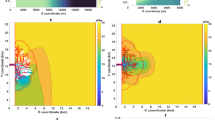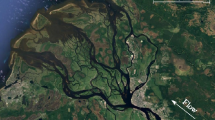Abstract
Variations in river hydraulic geometry (HG) are of fundamental importance to fluvial geomorphological research and catchment management. In tide-influenced river deltas, channel geometry displays a mixed scaling behavior since the channel forming discharge is of both tidal and river origins. This study aims to map the tidal signature on delta morphology in the Pearl River Delta (PRD) channel network. The model results of a 2D numerical model are used to analyze the spatial variations of river and tidal discharges and their relations with representative channel geometry throughout the delta. Downstream HG of the distributary channels in the PRD features distinct characteristics in three zones. The transition points in morphology, which splits the delta into river- and tide-dominated parts, coincide with those in the mean flow velocity, the ratio of maximum tidal discharge amplitude (MTDA) to fluvial discharge. The ratio of MTDA to river discharge scales with bifurcation order. The water level setup created by non-linear tidal and fluvial interactions affects the discharge division at tidal bifurcations. In general, the net tidal impact is to attenuate the inequality in discharge division in the PRD. The tide is non-negligible in the cross-sectional morphology and plays a decisive role in the formation of the river channel in the seaward portion of the delta.














Similar content being viewed by others
References
Allen JI, Somerfield PJ, Gilbert FJ (2007) Quantifying uncertainty in high-resolution coupled hydrodynamic-ecosystem models. J. Mar. Syst 64:3–14. https://doi.org/10.1016/j.jmarsys.2006.02.010
Beaufort A, Moatar F, Curie F, Ducharne A, Bustillo V, Thiéry D (2016) River temperature modelling by Strahler order at the regional scale in the Loire river basin, France. River Res Appl 32:597–609. https://doi.org/10.1002/rra.2888
Braconnot P, Joussaume S, Marti O, de Noblet N (1999) Synergistic feedbacks from ocean and vegetation on the African monsoon response to mid-Holocene insolation. Geophys Res Lett 26:2481–2484. https://doi.org/10.1029/1999GL006047
Buschman FA, Hoitink AJF, Van Der Vegt M, et al (2009) Subtidal water level variation controlled by river flow and tides. Water Resources Research 45(10): W10420, 1–12
Buschman F A, Hoitink A J F, Van Der Vegt M, et al (2010) Subtidal flow division at a shallow tidal junction. Water Resources Research 46(12): W12515, 1–12
Chen XH, Chen YQ (2002) Hydrological change and its causes in the river network of the Pearl River Delta. J Geogr Sci 57:430–436 (in Chinese)
Chen X, Zhang W, Zhao H, Xu H, Yi W (2010) Spatio-temporal characteristics and effects of shoreline evolution of the Pearl River estuary in the past thirty years. Trop Geogr 30(6):591–596 (in Chinese)
Claussen M, Brovkin V, Ganopolski A (2001) Biogeophysical versus biogeochemical feedbacks of large-scale land cover change. Geophys Res Lett 28:1011–1014. https://doi.org/10.1029/2000GL012471
D’Alpaos A, Lanzoni S, Marani M, Rinaldo A (2010) On the tidal prism-channel area relations. J Geophys Res 115:F01003. https://doi.org/10.1029/2008JF001243
Davies G, Woodroffe CD (2010) Tidal estuary width convergence: theory and form in north Australian estuaries. Earth Surf Process Landf 35(7):737–749
Dodov B, Foufoula-Georgiou E (2004) Generalized hydraulic geometry: insights based on fluvial instability analysis and a physical model. Water Resour Res 40:W12201. https://doi.org/10.1029/2004WR003196
Dupas R, Curie F, Gascuel-Odoux C, Moatar F, Delmas M, Parnaudeau V, Durand P (2013) Assessing N emissions in surface water at the national level: comparison of country-wide vs. regionalized models. Sci Total Environ 443:152–162. https://doi.org/10.1016/j.scitotenv.2012.10.011
Edmonds DA, Slingerland RL (2007) Mechanics of river mouth bar formation: implications for the morphodynamics of delta distributary network. J Geophys Res 112(F02034):1–16
Fagherazzi S, Furbish DJ (2001) On the shape and widening of salt marsh creeks. J Geophys Res 106(C1):991–1003. https://doi.org/10.1029/1999JC000115
Friedrichs CT (1995) Stability shear stress and equilibrium cross-sectional geometry of sheltered tidal channels. J Coastal Res 11(4):1062–1074
Godin G (1985) Modifification of river tides by the discharge. Journal of Waterway, Port, Coastal, and Ocean Engineering 111(2):257–274. https://doi.org/10.1061/(ASCE)0733-950X(1985)111:2(257)
Goodwin P (2004) Analytical solutions for estimating effective discharge. J Hydraul Eng 130:729–738. https://doi.org/10.1061/(ASCE)0733-9429(2004)130:8(729)
Hogrefe C et al (2004) Simulating changes in regional air pollution over the eastern United States due to changes in global and regional climate and emissions. J Geophys Res 109:D22301. https://doi.org/10.1029/2004JD004690
Hoitink AJF, Wang ZB, Vermeulen B, Huismans Y, Kästner K (2017) Tidal controls on river delta morphology. Nat Geosci 10:637–645
Jay DA (1997) Interaction of fluctuating river flow with a barotropic tide: a demonstration of wavelet tidal analysis methods. J. Geophys. Res. 102(C3): 5705–5720. 10.1 029/96JC00496
Ji X, Zhang W (2019) Tidal influence on the discharge distribution over the Pearl River Delta, China. Reg Stud Mar Sci 31:100791
Ji X, Sheng J, Tang L, Liu D, Yang X (2011) Process study of circulation in the Pearl River Estuary and adjacent coastal waters in the wet season using a triply-nested circulation model. Ocean Model 28:138–160. https://doi.org/10.1016/j.ocemod.2011.02.010
Jia L, Yang Q, Haiqiang Q, Luo X, Luo Z, Yang G (2002) Variations in At-a-Station hydraulic geometry of the Pearl River Delta in recent decades. Sci Geogr Sin 22(1):57–62
Lamouroux N, Hauer C, Stewardson MJ, LeRoy Poff N (2017) Chapter 13–physical habitat modeling and ecohydrological tools. In: Horne AC, Webb JA, Stewardson MJ, Richter B, Acreman M (Eds.), Water for the Environment. Academic Press, pp. 265–285. https://doi.org/10.1016/B978-0-12-803907-6.00013-9
Langbein WB (1963) The hydraulic geometry of a shallow estuary. Bulletin-International Association of Scientifific Hydrology 8(3):84–94. https://doi.org/10.1080/02626666309493340
Lanzoni S, G Seminara (1998) On tide propagation in convergent estuaries, J. Geophys. Res. 103(C13): 30, 793–30, 812. https://doi.org/10.1029/1998JC900015
Lee JS, Julien PY (2006) Downstream hydraulic geometry of alluvial channels. J Hydraul Eng 132:1347–1352. https://doi.org/10.1061/(ASCE)0733-9429(2006)132:12(1347)
Leopold LB, Maddock T (1953) The hydraulic geometry of stream channels and some physiographic implications. U S Geol Surv Prof Pap 252:1–58
Lu XX, Zhang SR, Xie SP, Ma PK (2007) Rapid channel incision of the lower Pearl River (China) since the 1990s. Hydrol Earth Syst Sci Discuss 4:2205–2227
Luo XL, Zeng EY, Ji RY, Wang CP (2007) Effects of in-channel sand excavation on the hydrology of the Pearl River Delta, China. J Hydrol 343:230–239
Maddock I (1999) The importance of physical habitat assessment for evaluating river health. Freshw Biol 41:373–391. https://doi.org/10.1046/j.1365-2427.1999.00437.x
Mao Q, Shi P, Yin K, Gan J, Qi Y (2004) Tides and tidal currents in the Pearl River Estuary. Cont Shelf Res 24(16):1797–1808
Maréchal D (2004) A soil-based approach to rainfall-runoff modelling in ungauged catchments for England and Wales (Ph.D. thesis). Cranfield University
Miguel C, Lamouroux N, Pella H, Labarthe B, Flipo N, Akopian M, Belliard J (2016) Altération d’habitat hydraulique à l’échelle des bassins versants: impacts des prélèvements en nappe du bassin Seine-Normandie. Houille Blanche:65–74 (in French). https://doi.org/10.1051/lhb/2016032
Myrick RM and LB Leopold (1963) Hydraulic geometry of a small tidal estuary. U.S. Dept. Int., Geol. Surv. Prof. Pap. 422–B: 1–18
Nienhuis JH, Hoitink AJF, Törnqvist TE (2018) Future change to tide-influenced deltas Geophysical Research Letters 45. https://doi.org/10.1029/2018GL077638
Pearl River Water Resources Commission (1991) Pearl River records, Volume III. Guangdong Province Science and Technology Press, Guangzhou, China, 256 pp (in Chinese)
Rinaldo A, Fagherazzi S, Lanzoni S, Marani M, Dietrich WE (1999) Tidal networks: 3. Landscape-forming discharges and studies in empirical geomorphic relationships. Water Resour Res 35(12):3919–3929
Sassi MG and AJF Hoitink (2013) River flow controls on tides and tide-mean water level profiles in a tidal freshwater river. J Geophys Res Oceans 118: 4139–4151. https://doi.org/10.1002/jgrc.20297
Sassi MG, Hoitink AJF, de Brye B, Vermeulen B, Deleersnijder E (2011) Tidal impact on the division of river discharge over distributary channels in the Mahakam Delta. Ocean Dyn 61(12):2211–2228
Sassi MG, Hoitink AJF, de Brye B, Deleersnijder E (2012) Downstream hydraulic geometry of a tidally influenced river delta. J Geophys Res 117:F04022. https://doi.org/10.1029/2012JF002448
Savenije HHG (2012) Salinity and tides in alluvial estuaries, 2nd edn. Elsevier, New York
Smagorinsky J (1963) General circulation experiments with the primitive equations, part 1, basic experiment. Monthly Weather Review 91:99–164. https://doi.org/10.1175/1520-0493(1963)091<0099:GCEWTP>2.3.CO;2
Snelder T, Booker D, Lamouroux N (2011) A method to assess and define environmental flow rules for large jurisdictional regions. J Am Water Resour Assoc 47:828–840. https://doi.org/10.1111/j.1752-1688.2011.00556.x
Statzner B, Gore JA, Resh VH (1988) Hydraulic stream ecology: observed patterns and potential applications. J North Am Benthol Soc 7:307–360. https://doi.org/10.2307/1467296
Stein U, Alpert P (1993) Factor separation in numerical simulations. J Atmos Sci 50(4):2107–2115
Stewardson MJ, Datry T, Lamouroux N, Pell H, Thommeret N, Valette L, Grant SB (2016) Variation in reach-scale hydraulic conductivity of streambeds. Geomorphology 259(15):70–80
Syvitski JPM, Saito Y (2007) Morphodynamics of deltas under the influence of humans. Glob Planet Chang 57(3):261–282
Torma C, Giorgi F (2014) Assessing the contribution of different factors in regional climate model projections using the factor separation method. Atmos Sci Lett 15:239–244. https://doi.org/10.1002/asl2.491
van den Heever SC, Carrio GG, Cotton WR, DeMott PJ, Prenni AJ (2006) Impacts of nucleating aerosol on Florida storms. Part I: mesoscale simulations. J Atmos Sci 63:1752–1775. https://doi.org/10.1175/JAS3713.1
Williams PB, Orr MK, Garrity NJ (2002) Hydraulic geometry: a geomorphic design tool for tidal marsh channel evolution in wetland restoration projects. Restor Ecol 10(3):577–590
Wright LD, Coleman JM, Thom BG (1973) Processes of channel development in a high-tide-range environment: Cambridge Gulf-Ord River Delta, Western Australia. J Geol 81(1):15–41. https://doi.org/10.1086/627805
Yuan R, Zhu J (2015) The effects of dredging on tidal range and saltwater intrusion in the Pearl River estuary. J Coast Res 31(6):1357–1362
Zhang W, Xiaohong R, Zheng J, Zhu Y, Wu H (2010) Long-term change in tidal dynamics and its cause in the Pearl River Delta, China. Geomorphology 120(3–4):209–223
Zhang W, Wang W, Zheng J, Wang H, Wang G, Zhang J (2015) Reconstruction of stage-discharge relationships and analysis of hydraulic geometry variations: the case study of the Pearl River Delta, China. Glob Planet Chang 125:60–70
Zhang W, Feng HC, Hoitink AJF, Zhu YL, Gong F, Zheng JH (2017) Tidal impacts on the subtidal flow division at the main bifurcation in the Yangtze River Delta. Estuar. Coast Shelf Sci. 196: 301–314. /https://doi.org/10.1016/j.ecss.2017.07.008
Zhao HT (1990) Evolution of the Pearl River Estuary. Chinese Ocean Press, Beijing, p 357 (in Chinese)
Funding
This work was jointly supported by “National Key R&D Program of China” (No. 2017YFC0405900), “National Natural Science Foundation of China” (NSFC, Nos. 41506100, 41676078), and “the Fundamental Research Funds for the Central Universities, China” (No. 2018B13114).
Author information
Authors and Affiliations
Corresponding author
Additional information
Responsible Editor: Emil Vassilev Stanev
This article is part of the Topical Collection on the 11th International Workshop on Modeling the Ocean (IWMO), Wuxi, China, 17–20 June 2019
Rights and permissions
About this article
Cite this article
Ji, X., Zhang, W. Tidal impacts on downstream hydraulic geometry of a tide-influenced delta. Ocean Dynamics 70, 1239–1252 (2020). https://doi.org/10.1007/s10236-020-01391-3
Received:
Accepted:
Published:
Issue Date:
DOI: https://doi.org/10.1007/s10236-020-01391-3




